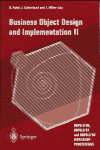 Patel , D., Sutherland, J., Miller, J., (Eds.) Business Object Design
and Implementation V: OOPSLA'99 Workshop Proceedings. Springer, 1999 (full
text available at the Workshop).
Patel , D., Sutherland, J., Miller, J., (Eds.) Business Object Design
and Implementation V: OOPSLA'99 Workshop Proceedings. Springer, 1999 (full
text available at the Workshop). Islam Choudhury, London Guildhall University, Department of Computing, Information Systems and Maths. email: iarchoud@lgu.ac.uk
Dilip Patel, South Bank University, School of Computing, Information Systems and Maths. email: dilip@sbu.ac.uk
A Generic Object Oriented Enterprise Modelling Process (GOOEMP) is a set of partially ordered steps intended to reach the objective of building a fully integrated, dynamic, object oriented model of the enterprise. An Abstraction Mechanism is proposed to enable this process. The process is generic because it applies to most types of enterprises. Enterprise models are the products developed from the process and these can be used by various stakeholders in an organisation to: a), give them an understanding of the enterprise; b), design integrated information systems; c), respond to business changes by evolving their enterprise models and information systems in a co-ordinated and coherent manner; and d), enable the enterprise models built within a particular industry to be reused and applied to many other industries.
Keywords: Enterprise Modelling Process (EMP), Generic Business Object Models, Enterprise Integration, Object Oriented Business Engineering, Abstraction Mechanism.
 Patel , D., Sutherland, J., Miller, J., (Eds.) Business Object Design
and Implementation V: OOPSLA'99 Workshop Proceedings. Springer, 1999 (full
text available at the Workshop).
Patel , D., Sutherland, J., Miller, J., (Eds.) Business Object Design
and Implementation V: OOPSLA'99 Workshop Proceedings. Springer, 1999 (full
text available at the Workshop).
Arrow, L., Barnwell, R., Burt, C. and Anderson, M.(eds.), 1995. OMG Business Object Survey. OMG Document 95-6-4. 25 May 1995
Bernus, P. and Nemes, L., 1996. A framework to define a generic enterprise reference architecture and methodology. Computer Integrated Manufacturing Systems 9(3), 1996, pp 179-191
Burkhart, R, Fulton, J., Gielingh, W., Marshall, C., Menzel, C., Petrie, C., and Zoutekouw, D., (1992). The Notion of a Model. Proceedings of the First International Conference on Enterprise Integration. Petrie, C. J., (ed.), pp 17-22.
Choudhury, I., Sun, Y., and Patel, D. (1997). Generic Reusable Business Object Model - A Framework and its Application in British Telecommunication plc. OOIS97 Proceedings, 4th International Conference on Object-Oriented Information Systems. Springer-Verlag, London.
Gale, T. and Eldred, J., (1996). Getting Results with the Object-Oriented Enterprise Model. SIGS Publications, New York. Graefe, U., and Chan, W., (1993). An Enterprise Model as a design tool for information infrastructure. Information Infrastructure Systems for Manufacturing (B-14), IFIP Transactions.
Yoshikawa, H., and Goossenaerts (eds.) Elsevier Science B. V., Holland., pp 183-192
Jacobson, I., Ericson, M. and Jacobson, A. (1995). The Object Advantage. Business Process Reengineering with Object Technology. ACM Press.
Malone, T.W., Crowston, K., Lee, J., Pentland, B., Dellarocas, C., Wyner, G., Quimby, J., Osborne, C., and Bernstein, A. (1997). Toward a handbook of organisational processes, Centre for Co-ordination Science, Massachusetts Institute of Technology, (http://ccs.mit.edu/CCSWP198).
Martin, J., (1989). Information Engineering, Book 1: Introduction, Prentice Hall, Englewood Cliffs, NJ. Shelton, R.E.A. (1994). Object-oriented business engineering: delivering the distributed enterprise, Proceeding of OOP'94, London, 1994, SIGS Publications, New York.
Taylor, D. A. 1995. Business Engineering with Object Technology. John Wiley and Sons, Inc. Vallespir, B., Chen, D., Zanettin, M. and Doumeingts, G., (1991). Definition of a CIM Architecture within the ESPIRIT Projects 'IMPACS', Computer Applications in Production Engineering: Integration Aspects, Elsevier, Amsterdam (1991) pp 731-738
Vernadat, F.B. 1992. CIMOSA - A European Development for Enterprise Integration. Part2: Enterprise Modelling. ESPIRIT Consortium AMICE. Proceedings of the First International Conference on Enterprise Integration. Petrie, C .J. 1992, pp 179-188
Williams, T.J. 1993. The Purdue Enterprise Reference Architecture Information Infrastructure Systems for Manufacturing (B-14), Yoshikawa, H. and Goosenaerts (eds.), Elsevier Science B. V., North Holland, pp 43-64
Zachman, J.A. A framework for information systems architecture, IBM Systems Journal, 26(3), 1987, pp276-292.